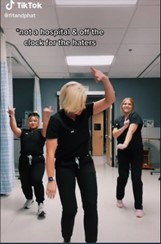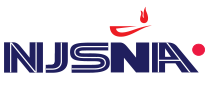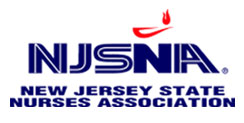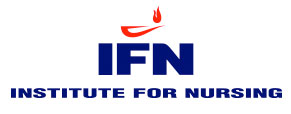Can TikTok’s ‘Dancing Nurses’ Hurt Profession?
 For two decades, Americans have consistently ranked nurses highest in honesty and ethics among all professionals1; indeed, nurses are often seen as heroic, a view furthered by the media, most recently during the COVID-19 pandemic.2 With the concurrent rise of social media, it’s increasingly common for frontline health care workers to post health-related messages directly to the public via platforms like Facebook, Instagram, TikTok, and YouTube. Even the mainstream news outlets often report on trending videos. While many videos are educational, some may send mixed messages or provide misinformation, possibly downplaying the seriousness of given illnesses or conditions and misleading the public.3-5
For two decades, Americans have consistently ranked nurses highest in honesty and ethics among all professionals1; indeed, nurses are often seen as heroic, a view furthered by the media, most recently during the COVID-19 pandemic.2 With the concurrent rise of social media, it’s increasingly common for frontline health care workers to post health-related messages directly to the public via platforms like Facebook, Instagram, TikTok, and YouTube. Even the mainstream news outlets often report on trending videos. While many videos are educational, some may send mixed messages or provide misinformation, possibly downplaying the seriousness of given illnesses or conditions and misleading the public.3-5
Recent reports found in the mainstream news media and elsewhere have profiled several pandemic-related videos made and shared by health care workers that show them singing and dancing as ways to relieve stress, boost morale, and celebrate the recovery of COVID-19 patients.6, 7 Yet certain videos can be disturbing for some viewers. For example, a video of dancing health care workers carrying a body bag labeled COVID-19, all while donned in personal protective equipment thought to be in short supply, drew sharp criticism.8 For one, this video struck many viewers as disrespectful and in “poor taste.” For another, given that the pandemic has exacerbated difficult working conditions, understaffing, and supply shortages,9-11 such videos can seem irresponsible.
As the numbers of posts, memes, and videos increase, some health care professionals are using social media to alter traditional stereotypes, rebranding themselves as both health care professionals and social media influencers.12 Generally speaking, a social media influencer is a social media user who has or claims knowledge and expertise in a specific area, creates and shares content, and attracts a sizable following. Influencers often post content related to current discussion topics in the popular culture, such as dancing and music trends.
The rise of TikTok as a communication conduit is in itself noteworthy. The platform, which allows users to post short videos (at the time of this study, 15 to 60 seconds or three minutes) set to music or other sounds, was released worldwide in 2018; it is the fastest growing social media platform in the world, with over 1 billion monthly active users as of July 2022.13 In the United States, 25% of all TikTok users are between the ages of 10 and 19 years.14 Although research on this new platform has been limited, early evidence suggests that its COVID-19-related content plays a role in shaping how the public views and responds to the pandemic.15 Recently several trends specific to nurses have emerged on TikTok, as evidenced by searching the platform using hashtags such as #nurse, #dancingnurse, #nursehumor, #nurselife, and #nursesoftiktok, which will yield multiple popular videos, many having millions of views and shares. (Recall that placing the hashtag symbol # before a word or phrase allows users to find, follow, and share specific content.16) But it’s unknown to what degree nurses—or the general public—consider the content of some videos to be a breach of professional ethics and standards.
Relevant professional standards. Nursing practice standards draw from many sources, including professional organizations, state regulatory bodies, and employers. In the United States, professional conduct is largely guided by the American Nurses Association (ANA). The ANA’s purview includes setting standards of practice, promoting nurses’ workplace rights, and advancing health care policies.17 Its Code of Ethics for Nurses with Interpretive Statements serves as a framework for conduct and decision-making,18 and is considered an active expression of nurses’ commitment to the profession. The Code of Ethics “establishes the ethical standard for the profession” and “is foundational . . . in its expression of the values, virtues, and obligations that shape, guide, and inform nursing as a profession.”18 Regarding social media, the ANA’s fact sheet Navigating the World of Social Media states, “Nurses and nursing students have an obligation to understand the nature, benefits, and consequences of participating in social networking of all types.”19
In addition, each state has its own nurse practice act that defines scope of practice, governs nurses’ duties and responsibilities, and establishes grounds for disciplinary action.20 A recent policy statement by the National Council of State Boards of Nursing (NCSBN) cautions nurses “to recognize that dissemination of misinformation not only jeopardizes the health and well-being of the public, but may place their license and career in jeopardy as well.”21 Clearly, it is imperative that nurses understand and apply these standards at all times and in all situations—including during this pandemic. Nurse leaders nationwide must also be cognizant of nurses’ (and nursing students’) activities on social media.
Study purpose. In conducting this study, we wanted to understand how nurses’ use of social media might be violating professional ethical standards. The study purpose was to examine and describe the use of the social media platform TikTok by “dancing nurses”—nurses who incorporate dance into their videos. Specifically, we sought to describe the following: the nature of the observed dancing (type of dancing, such as whether choreographed or freestyle), any messages about COVID-19, any geographic or other identifiable information that was displayed, numbers of views and followers, COVID-19 morbidity and mortality rates at the date and time of posting, and how the ANA Code of Ethics and ANA and NCSBN social media recommendations applied to a given video.
METHODS
Study design. This study used a qualitative descriptive study design. Steps included selection of content within defined parameters, definition of units for analysis, development of coding rules, coding of the defined units, and qualitative content analysis of findings.22, 23 The University of Wisconsin’s institutional review board determined that no approval was needed, as all videos are in the public domain.
Content selection and retrieval. All videos selected for content analysis were retrieved and viewed on the public open-source social media networking platform TikTok. This took place between March 1 and December 31, 2020.
We searched TikTok using the terms nurse, dancing, and COVID in various combinations and as hashtags (for example, #dancingnurse). After entering a term in TikTok’s “search accounts and videos” field, users can search under three options: “top,” “accounts,” and “videos.” TikTok does not provide the total number of videos or other count data for a given search term. But searching “top” videos for that term does produce a list of videos. Although TikTok bases designation as a top video on a proprietary algorithm, it’s thought the method centers on trending hashtags, catchy captions, currently popular content, and other such data.24 TikTok trends evolve from day to day and sometimes even more rapidly.
Videos were included for analysis if they contained at least one of the search terms or hashtags, and if they were made by and featured someone who appeared to be a nurse in what looked like a health care setting. Videos were excluded from analysis if they were filmed outside the United States or if they appeared to have been filmed somewhere other than in a clinical or hospital setting. Videos posted by a person who was presumably not a nurse (as indicated by hashtags such as #certifiednursingassistant or #respiratorytherapist) were also excluded.
A spreadsheet of video links was created for videos meeting these criteria. Because trending videos change from day to day, this process was repeated until saturation occurred. Other information about the TikTok post and user was gathered on the day of posting.
Data analysis. A qualitative content analysis approach was used.23 The coding rubric was developed through a deductive method. First, the research team collaboratively examined several of the first videos found in order to understand the basic characteristics of the content. The original goal was only to describe the nature of the dancing and apply the ANA Code of Ethics,18 the ANA’s social networking principles,19 and the NCSBN’s social media guidelines25 to the videos. (See Table 118, 19, 25, 26 for a summary of the applied provisions, principles, and guidelines.) Through repeated systematic observation of the videos, however, other variables of interest emerged. Such variables included numbers of followers, views, and likes as well as other user account information. These variables were defined, refined, and included in the study. (See Table 218, 25, 26 for the full list of defined and operationalized variables.)
Coding the videos. The coding rubric was applied. Count data (numbers of followers, views, and likes) were collected for videos that met the inclusion criteria. For each video, COVID-19 morbidity and mortality rates were collected on the day of posting via the New York Times COVID-19 tracker.27 Once initial coding was completed, all four researchers independently reviewed all videos. Each of us rated our level of agreement regarding each documented observation for type of dance and for any violations of the aforementioned code provisions, social networking principles, and social media guidelines, using the following scale: 1 = yes/agree with observation, 2 = no/disagree with observation. To address interrater reliability, two-way mixed intraclass correlation coefficients were calculated. Reliability was calculated after all videos were initially coded and after four videos had been removed either by the user or by TikTok. Results for the remaining 48 videos were as follows: type of dance, r = 0.49; violation(s) of ANA Code of Ethics provisions, r = 0.37; ANA social networking principles, r = 0.19; and NCSBN social media guidelines, r = 0.05. Saturation was achieved when no new variables germane to this analysis emerged. All data were calculated using IBM SPSS version 25.
RESULTS
Fifty-two TikTok videos met the inclusion criteria and were analyzed. The mean duration of the videos was 12.88 seconds (range, 6 to 30 seconds). Forty videos (77%) included a choreographed dance. Of the 52 videos, 24 (46%) featured twerking, while three (6%) featured other moves (such as pelvic thrusts and gyrations). Thirteen videos (25%) contained the word “COVID” in the hashtag. Despite being so tagged, these videos had no embedded messages about COVID-19. Nearly all of the videos (96%) displayed some element of identifiable information (such as the name of a nurse or hospital system). One video showed a patient chart in which the hospital, a physician’s name, and a list of ordered diagnostic scans were visible. No identifiable patient health information was seen.
The mean number of views per video was 1.51 million (range, 90 to 19,000,000). The mean number of followers for the person posting one of the selected videos was 635,047 (range, 87 to 25,000,000). Mean COVID-19 morbidity and mortality rates for the day of posting were 58,335 (range, 0 to 601,138 cases) and 1,225 (range, 45 to 4,665 deaths), respectively. Four of the analyzed videos (8%) have been removed since their original posting for unknown reasons. One of the deleted videos was linked to a nurse’s personal pornography channel.
In total, across the three sets of provisions, principles, and guidelines, there were 356 violations. Regarding the ANA Code of Ethics, provisions 6 (n = 51, 98%), 7 (n = 50, 96%), and 9 (n = 50, 96%) were the most frequently violated. The ANA social networking principles 3 (n = 51, 98%) and 4 (n = 51, 98%), as well as the NCSBN social media guidelines 7 (n = 51, 98%) and 9 (N = 52, 100%), were also frequently violated. Overall, there were 253 violations of ANA provisions and principles, and 103 violations of NCSBN guidelines. Twelve of the videos (23%) specifically referred to COVID-19 or the pandemic in their description by using hashtags such as #COVID-19, #coronavirus, #socialdistancing, #healthcareheroes, #stayhome, and #pandemic. Other than through hashtags, the videos contained no specific references to the pandemic.
Three exemplars. Several videos could serve as exemplars, three of which are described in more detail below. (For the full list of sample videos, contact the corresponding author.) The first exemplar, video #1, was posted by a telemetry medical–surgical nurse. The caption reads “Night shift has been kicking my butt. As I approach 10 years of being a nurse and working nights . . . my body says ‘HELL NO.’” In this video, the nurse is in uniform and seated at a nursing station with a telemetry monitor running in the background. After spinning in the chair, the nurse crouches and starts twerking. The accompanying music, a clip from Queen of the Ratchet’s “Gold Digger for Life,” features the lyrics “Hey, I-ya need a sugar daddy to come pay my bills, pay my bills,” and sounds similar to “Circle of Life” from the Broadway hit musical The Lion King. At the time of data collection, this user had 10,300 followers and 317,200 combined likes for various videos; this video alone had 6,917 views and 501 likes.
Video #9, the second exemplar, features three nurses dancing and twerking to a clip from the song “Booty” by Blac Youngsta. The lyrics heard include “Shake that booty in the car [shake], shake that booty in the store [shake], . . . Pop it, stop it, drop it, pop it.” The nurses wear patient gowns over their scrubs, with pillows stuffed into the rear to exaggerate the buttocks. This user had 137 followers and 141 combined likes for various videos; this video had 3,025 views and 14 likes.
The third exemplar, video #15, features a male nurse dressed in full scrubs, complete with operating room cap, dangling mask, and name tag, dancing to a clip from the song “Chandelier” by Sia. The lyrics heard are “I’m gonna swing from the chandelier, from the chandelier.” In the video, the outline of his genitals through the scrub pants is visible as he dances, gyrating and licking his hands. This user had 71,500 followers and over 600,000 combined likes for various videos; this video had 73,900 views and more than 8,000 likes.
DISCUSSION
TikTok has been around less than a decade, and there have been few peer-reviewed studies specifically examining nurse-related trends on that platform. Early research suggests that TikTok can play an important role in propagating useful health information to the public.28, 29 Yet concerns about misinformation on this and other social media platforms continue to be an issue. Indeed, in November 2021, several national nursing organizations endorsed an NCSBN policy statement cautioning nurses to adhere to the ANA Code of Ethics and to be professional and accountable for any health information publicly shared.21, 30 The policy statement warns nurses about possible disciplinary action for any spreading of misinformation. But it doesn’t address other behaviors that could be seen as downplaying the seriousness of illness, sending mixed messages, or that otherwise could be construed as unprofessional conduct. This is especially concerning given the ongoing pandemic. The videos were posted during a time when the rates of COVID-19–related illness and death were high.
Our study focused on TikTok videos that were posted by nurses and depicted a hospital or other clinical setting. As described above, we examined the selected videos through the lens of the ANA Code of Ethics and identified numerous violations, most commonly to provisions 6, 7, and 9. These provisions pertain, respectively, to the nurse’s obligation to maintain “the ethical environment of the work setting . . . [such that it is] conducive to safe, quality health care”; advance the profession in all settings; and “articulate nursing values [and] maintain the integrity of the profession.”18 Similarly, the most common violations to the ANA social networking principles were to principles 3 and 4, which respectively pertain to understanding the public nature of posts and using privacy settings “to separate personal and professional information online.”19 The most common violations to the NCSBN guidelines were to guidelines 7 and 9, which respectively state that nurses must “maintain professional boundaries in the use of electronic media” and “promptly report any identified breach of confidentiality or privacy.”25
Moreover, while searching TikTok, we encountered other trending videos that had been filmed in private settings and featured apparent nurses wearing very little clothing and engaging in what could be construed as sexually suggestive behaviors. Although not included in the analysis, these videos also concerned us, as the image of the nurse is already in jeopardy.31, 32 Studies have found the profession’s image problems to be associated with several factors, including variations in educational requirements, lack of professionalism, historical sexual stereotyping, and hypersexualized or pornographic portrayals in the media.31, 32 The dancing nurse trend on TikTok has become so popular that nonnurse users sometimes pose as nurses for increased likes and shares. In a recent Saturday Night Live skit, “nurses” danced and twerked while a “patient” died in the background. The skit was based on a video posted on TikTok by a nurse.
Nurses who use social media should be aware of the potential risks. There is precedence for suspension or termination from employment for unprofessional conduct, including conduct on social media, on or off duty, judged to be unethical.33-35 In 2013, an ED nurse in New York City posted a photograph on Instagram of an empty trauma room just after a person struck by a subway train had been treated there.33 The nurse lost her job when this behavior was deemed insensitive by hospital administration. More recently, a North Carolina nurse working at a long-term care facility was suspended, after multiple complaints from the public, for posting videos on TikTok in which she “joked about mistreating her patients.”34 Although the nurse defended the videos as “just dark humor,” the organization decided that her actions violated its core values. And an oncology nurse in Oregon was put on administrative leave for posting TikTok videos in which she openly refused to follow pandemic restrictions.35 At this writing, it’s unknown whether either state’s board of nursing has taken disciplinary action; both nurses are still practicing with unrestricted licenses.
Recommendations. Nurses have a professional obligation to be familiar with and abide by ANA and NCSBN principles and standards regarding the use of social media, as well as state board of nursing regulations governing professional conduct. It’s vital that nurses understand that these standards and regulations apply to their use of social media both on and off duty. Nurse managers have an added obligation to uphold professional standards and regulations among those they manage.36 Deciding what constitutes a violation of professional standards and what does not can be challenging as the profession learns to navigate these new virtual territories.
Many health care organizations have established social media use policies; others may be in the process of doing so. As a first step, we recommend examining the ANA and NCSBN social media principles and standards, and instituting or adapting them. An organization’s public relations department might consider reviewing any employee-created social media video filmed in the hospital or other clinical setting before approving it for posting. Alternatively, the organization could consider a policy banning staff from making videos set in the hospital or other clinical setting and posting them on public platforms. Systems and structures designed to allow anonymous reporting of questionable social media content that could negatively impact the organization may warrant exploration.
Further research aimed at understanding what motivates nurses to post questionable content is essential. Specific areas of interest include determining how a nurse’s desire to become “TikTok famous” might take precedence over modeling professionalism. Regarding the creation and posting of social media, research should examine the following: the overt and covert messages disseminated; the current public health context; whether content creation took time away from patient care; whether patients’ pain and suffering is exploited to accrue views, likes, and followers; consideration of professional image; and consideration of possible repercussions.
Limitations. This study had several limitations. First, the URLs were collected over several months, and TikTok is a dynamic platform where trends evolve rapidly. Moreover, TikTok searches are driven by proprietary algorithms, such that each user’s encounter is unique, with no two users finding exactly the same content. Second, we sought only videos that featured “dancing nurses,” which limited the scope of what we found; there is undoubtedly other important content produced by nursing professionals. Because we focused on selected words and phrases as isolated entities, we may have missed nuances and ambiguous meanings. Third, the interpretation of observed dancing and whether a video violates professional ethical standards is highly subjective, which potentially affects the validity of the results. The low values for interrater reliability may be reflective of generational age differences among research team members. Finally, this study was limited to content found on one platform, TikTok. An informal search for similar content on YouTube yielded a number of videos of dancing nurses, to generally more favorable reviews. This might be because many of these were posted under a facility or organization’s official YouTube account, and more oversight may have been involved.
CONCLUSIONS
The findings from this analysis provide some insight into how nurses are using TikTok, specifically regarding the recent trend of videos that feature dancing nurses. Some of the analyzed videos included content that could be construed, in our view, as inappropriate and even sexually suggestive. The concern is that such videos could damage the professional image of nurses and downplay the seriousness of the current pandemic. It’s essential that nurses who use social media carefully consider the content and presentation of what they post, in light of how it might impact their careers and the nursing profession. Furthermore, organizations and nurse leaders need to consider how to apply professional ethical guidance to social media use by nurses. Given the ongoing pandemic and the rising use of such media, there is an urgent need for nurses to understand professional and workplace social media guidelines and policies, and how these may apply to content developed and posted on platforms such as TikTok.
- Authors: Lancaster, Rachelle PhD, RN; Sanchez, Michelle BSN, RN; Maxwell, Kelly BSN, RN; Medley, Rachel BSN, RN
(This story originally appeared on American Journal of Nursing.)




